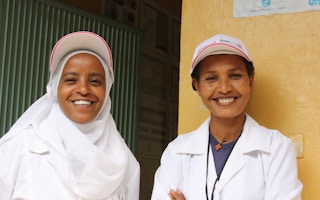In every phase of the COVID-19 pandemic, community health workers have been indispensable. They have made diagnoses, carried out contact tracing, cared for the sick and administered vaccinations. And they have performed all these tasks with minimal funding, supervision, and assistance.
The use of community health workers in rural health care has a long track record of success. In the 1960s, China’s “barefoot doctors” helped the country eradicate smallpox and double life expectancy. A decade later, Bangladesh partly emulated the Chinese initiative when it launched its community health worker program. It helped the country achieve a majority of the health-related Millennium Development Goals, such as bringing the diphtheria-tetanus-pertussis vaccination rate for rural children from near-zero in the 1980s to more than 90 per cent today.
Community health workers are not doctors or nurses. They are local residents with basic medical training who help bridge the gap between health-care facilities and underserved populations. Usually, they are trained by non-governmental organisations and receive little or no compensation from their governments. In fact, few governments around the world keep records of community health workers or have a way to communicate with them.
These committed people can be the backbone of the resilient health systems needed to manage the next pandemic. But for that to happen, they need more support.
The challenges faced by community health workers around the world are significant. Many, like Nepal’s 50,000 female community health volunteers, are unpaid, even though the value of the free treatment and labour such workers provide worldwide is estimated at US$1.5 trillion.
But money is only one problem. In Brazil, some community health workers receive only one or two weeks of training before they begin unsupervised work. Community health workers in Ethiopia spend more time traveling than treating patients because of the rural and remote nature of the communities they serve. A survey in Liberia in 2018 and 2019 found that fewer than half of community health workers had stocks of lifesaving zinc or amoxicillin. And just over half had oral rehydration solution and malaria drugs – crucial tools in a country where thousands of people die of diarrhoea and malaria each year.
It is little wonder that many community health worker programs experience high levels of attrition and vacancies. In Bangladesh, 15 per cent of positions are vacant at any given time. Staff turnover increases costs, because replacements have to be recruited, trained, and deployed. It also reduces the quality of care, as new workers generally have less hands-on experience providing health services.
The pandemic exposed the need for strong and adaptable health systems, particularly in underserved communities. To build these systems, we must find a way to recruit, train, equip, supervise and remunerate frontline workers properly.
For starters, groups that operate community health worker programs should review and strive to follow the World Health Organization’s recommendations on support for community health workers.
Moreover, governments should develop and maintain up-to-date, geo-referenced national registries of community health workers. These databases can be used to communicate public-health messages, improve links between rural communities and health clinics, and manage crises. Keeping track of community health workers also can help ensure that they are trained and equipped properly.
Lastly, governments and funding partners should look for other ways to assist community health workers. One under-recognised and cost-effective tool is a sturdy bicycle. World Bicycle Relief, working with civil-society organisations like the Catholic Medical Mission Board and health ministries in seven countries, has distributed nearly 175,000 of its specially designed Buffalo Bicycles, allowing community health workers to spend less time in transit and more time with patients.
Bicycles have improved health outcomes in several African countries. In Kenya, bike-riding community health workers saw 88 per cent more patients and referred 50 per cent more patients for tuberculosis screening at a local clinic. Community health workers equipped with bicycles in Zambia quadrupled the frequency of visits to their patients. In Malawi, they doubled the number of patients they could visit.
Surveys show that community health workers who have bicycles are less likely to quit. Likewise, if program supervisors have bicycles, they can provide more guidance to community health workers, leading to better care for patients and more job satisfaction for caregivers.
When the acute phase of the COVID-19 pandemic comes to an end, it largely will be thanks to the tireless work of community health workers. The best thing the world can do to maximise their effectiveness in future crises is to ensure they are properly trained, equipped, empowered and even compensated.
Mary Beth Powers is CEO of the Catholic Medical Mission Board. Dave Neiswander is CEO of World Bicycle Relief.
© Project Syndicate 1995–2022












